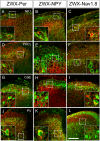Triggering genetically-expressed transneuronal tracers by peripheral axotomy reveals convergent and segregated sensory neuron-spinal cord connectivity
- PMID: 19647044
- PMCID: PMC2760676
- DOI: 10.1016/j.neuroscience.2009.07.051
Triggering genetically-expressed transneuronal tracers by peripheral axotomy reveals convergent and segregated sensory neuron-spinal cord connectivity
Abstract
To better understand the mechanisms through which non-painful and painful stimuli evoke behavior, new resources to dissect the complex circuits engaged by subsets of primary afferent neurons are required. This is especially true to understand the consequences of injury, when reorganization of central nervous system circuits likely contributes to the persistence of pain. Here we describe a transgenic mouse line (ZWX) in which there is Cre-recombinase-dependent expression of a transneuronal tracer, wheat germ agglutinin (WGA), in primary somatic or visceral afferent neurons, but only after transection of their peripheral axons. The latter requirement allows for both regional and temporal control of tracer expression, even in the adult. Using a variety of Cre lines to target WGA transport to subpopulations of sensory neurons, here we demonstrate the extent to which myelinated and unmyelinated "pain" fibers (nociceptors) engage different spinal cord circuits. We found significant convergence (i.e., manifest as WGA-transneuronal labeling) of unmyelinated afferents, including the TRPV1-expressing subset, and myelinated afferents to NK1-receptor-expressing neurons of lamina I. By contrast, PKCgamma interneurons of inner lamina II only receive a myelinated afferent input. This differential distribution of WGA labeling in the spinal cord indicates that myelinated and unmyelinated sensory neurons target different and spatially segregated populations of postsynaptic neurons. On the other hand, we show that neurons of deeper laminae (III-V) receive direct (i.e., monosynaptic) inputs from myelinated afferents and polysynaptic input from unmyelinated afferents. Taken together, our results indicate that peripheral sensory information is transmitted to the central nervous system both through segregated and convergent pathways.
Figures







References
-
- Amaya F, Decosterd I, Samad TA, Plumpton C, Tate S, Mannion RJ, Costigan M, Woolf CJ. Diversity of expression of the sensory neuron-specific TTX-resistant voltage-gated sodium ion channels SNS and SNS2. Mol Cell Neurosci. 2000;15:331–342. - PubMed
-
- Braz JM, Nassar MA, Wood JN, Basbaum AI. Parallel “pain” pathways arise from subpopulations of primary afferent nociceptor. Neuron. 2005;47:787–793. - PubMed
-
- Brown JL, Liu H, Maggio JE, Vigna SR, Mantyh PW, Basbaum AI. Morphological characterization of substance P receptor-immunoreactive neurons in the rat spinal cord and trigeminal nucleus caudalis. J Comp Neurol. 1995;356:327–344. - PubMed
Publication types
MeSH terms
Substances
Grants and funding
LinkOut - more resources
Full Text Sources
Other Literature Sources
Molecular Biology Databases

